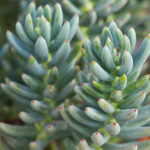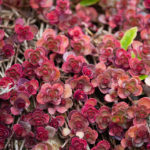by Emily Cross Reeves
Replacing a grass lawn with low-water, low-maintenance xeriscape seems like a no-brainer to many people who live through the dry, hot summers of Colorado, but somehow we still see grass lawn after grass lawn in neighborhoods across the state. Why? Oftentimes a grass lawn is left alone because people are concerned about the cost of replacing it with a xeric garden.
The truth is, a xeric garden can actually save you quite a bit of money over time if you can commit to a modest budget and a bit of hard work up front. So, if you’re ready to install a xeric garden and watch your water bill shrink (and your curb appeal grow), take a look at these tips on how to xeriscape on a budget.
The first step to xeriscaping your yard on a budget is to design and plant your xeric garden yourself. When you by-pass the professionals, you save a lot of money, but you also risk making a few mistakes. To decrease the risk, do your homework about drought-tolerant plants that will do well in your area and take some time to create a garden design on grid paper.
If you’re xeriscaping your yard in Colorado, one of your best options is to buy a pre-planned garden like Garden In A Box. These gardens arrive with plants that are known to thrive in Colorado and a few design options are included. Garden In A Box pre-planned gardens are one of the best ways to xeriscape your yard without spending a ton of money, thanks to a generous plant discount and free design plans.
2) Keep purchased hardscape to a minimum
If you already have hardscapes like boulders, river rock, and flagstone in your yard, consider yourself lucky. If not, consider using other design elements that are less pricey. For instance, one cost-effective option for pathways is to make your own stepping-stones with a fast-setting concrete mix and a mold. You can add artistic elements to the concrete like leaf imprints, small tiles, and marbles, too! Gravel, woodchips, and mulch are also budget-friendly alternatives to flagstone patios and pathways, and allow you to install hardscape overtime if you wish.
3) Grow from seed and collect plant divisions from friends and neighbors

The most cost-effective way to fill your yard with drought-tolerant plants? Grow plants from seed and collect divided, mature plants from friends.
Collecting or buying seeds are always cheaper than buying full-grown plants. However, there is a downside to growing most of your plants from seeds – the timeline. It will take your xeric garden longer to mature if you are starting from seed. The best fix to this problem is to grow annuals and biennials in your garden as the perennials get established. Of course, if you have to buy all of the equipment in order to grow your plants from seeds, this may not cut your costs all that much. But you have other options!
If you have friends or neighbors with established gardens, chances are that they will have some plants in their yard that can be divided and given to you. You may also find someone online who is giving away divided or volunteer plants for free. I picked up five free Salvia plants last spring from someone who posted on Facebook. Now, they are all planted in my new xeric garden and doing great.



4) Use non-invasive plants that spread
As long as you avoid invasive species and take care in researching your plants before planting them, xeriscaping with plants that spread by self-seeding, runners or division is an easy way to cut costs because you will be buying fewer plants to fill your space.
Some favorite drought-tolerant plants that spread or can be divided regularly include coneflower, sedum, bearded iris, salvia, lupine, Russian sage and bee balm (many of these are found in various options of Garden In A Box). Low-water groundcovers that spread easily include various types of speedwell, thyme, and low-growing sedum like Angelina stonecrop. Some annuals that spread by seed include zinnia, petunia, marigold and sunflower.
5) Make your own mulch
If you or a friend has a shredder/mulcher, you can make mulch that is of a much higher quality than anything you can buy from a nursery or landscape supply store. Shredded leaves and small clippings make great mulch that will stop weeds, slow water evaporation and improve soil health. Just be mindful of the extremely xeric plants that don’t like to “get their feet wet.” Avoid putting mulch too close to the base of these plants and opt for a bit of pea gravel, instead.
Ready to replace your grass with beautiful, low-water xeriscape and start saving money on your water bill? Want to accomplish that xeriscape on a budget? We can help! Check out our Grass to Garden turf replacement program, pre-planned Garden In A Box options and these step-by-step tips on xeriscaping your yard.













